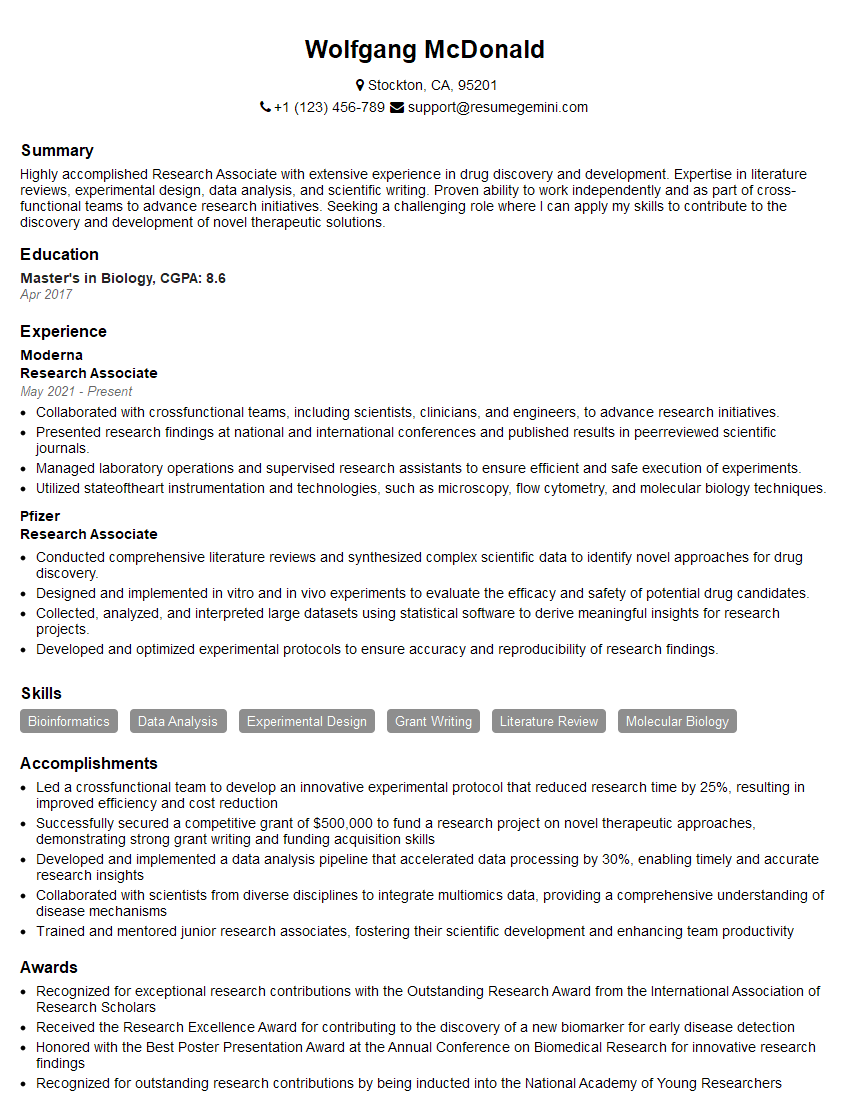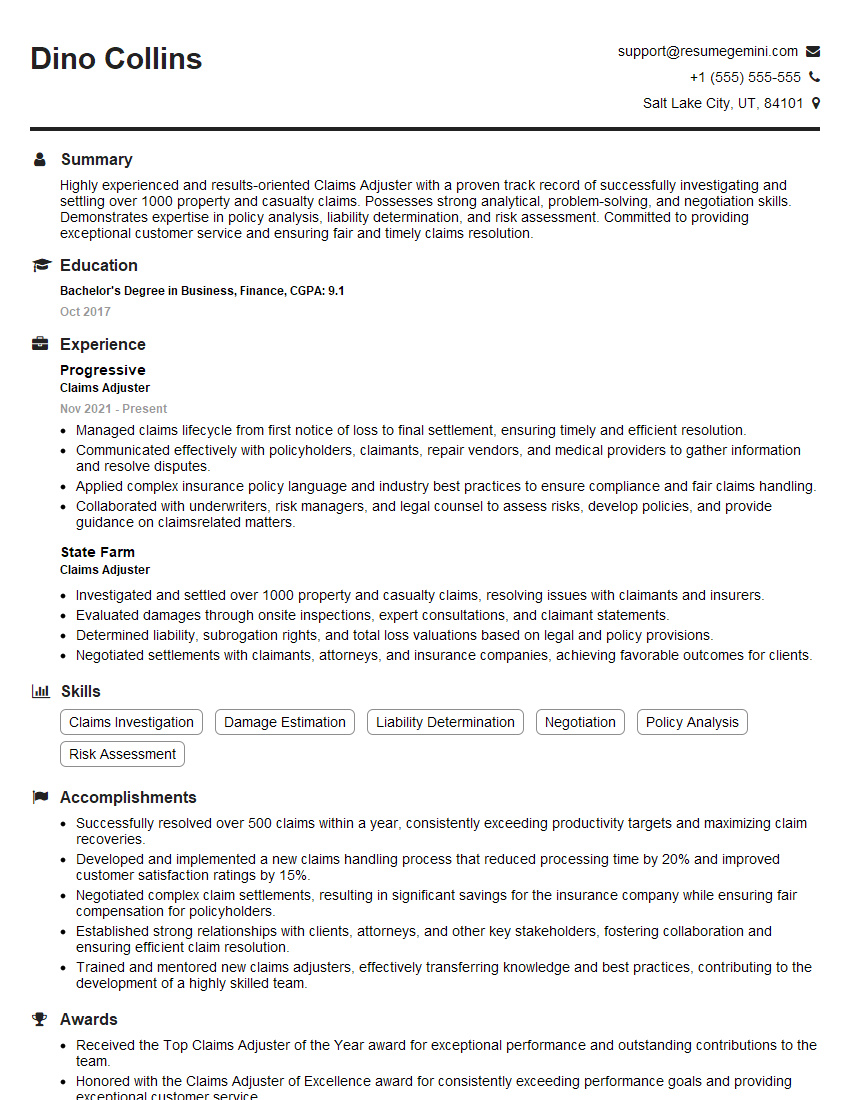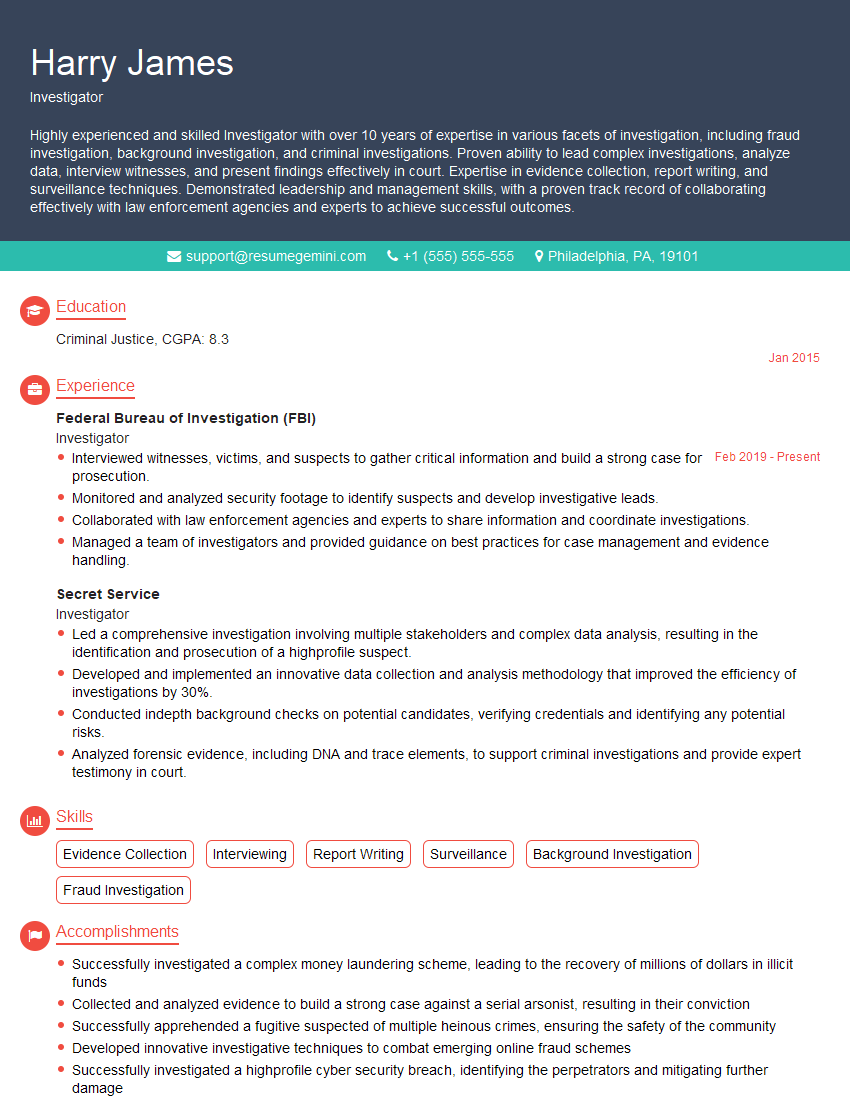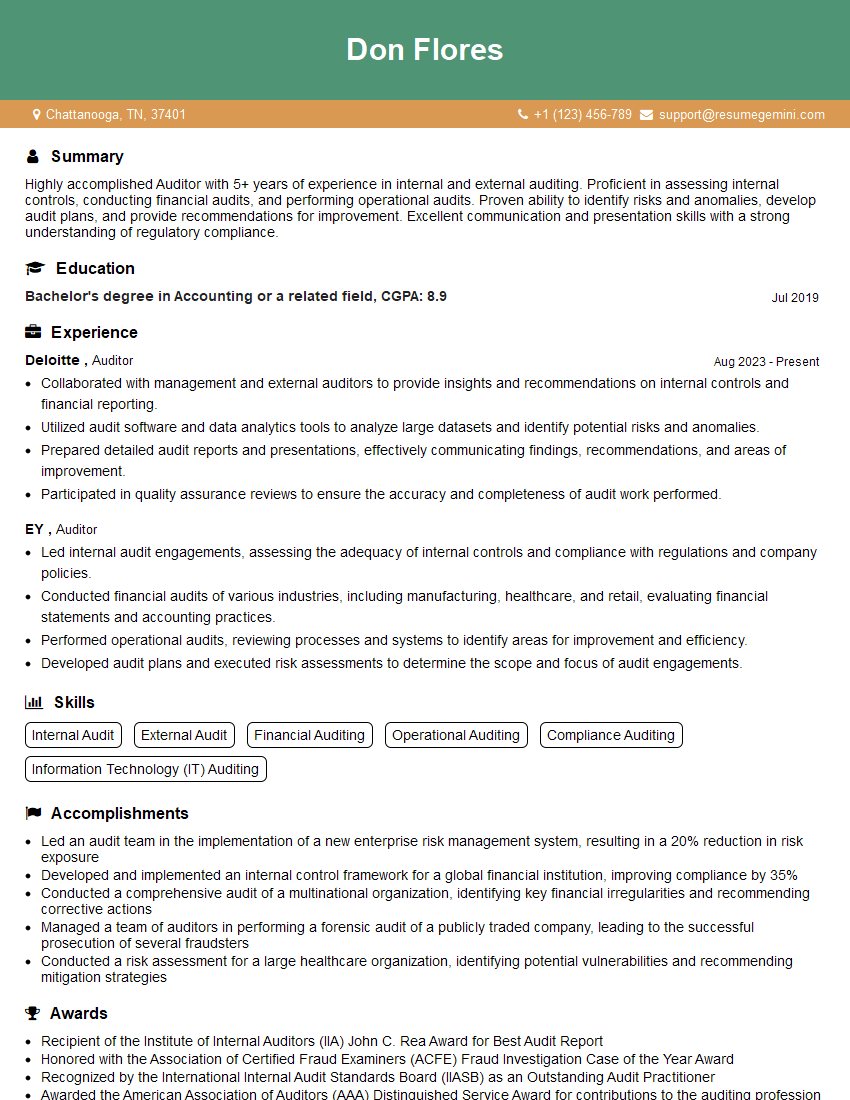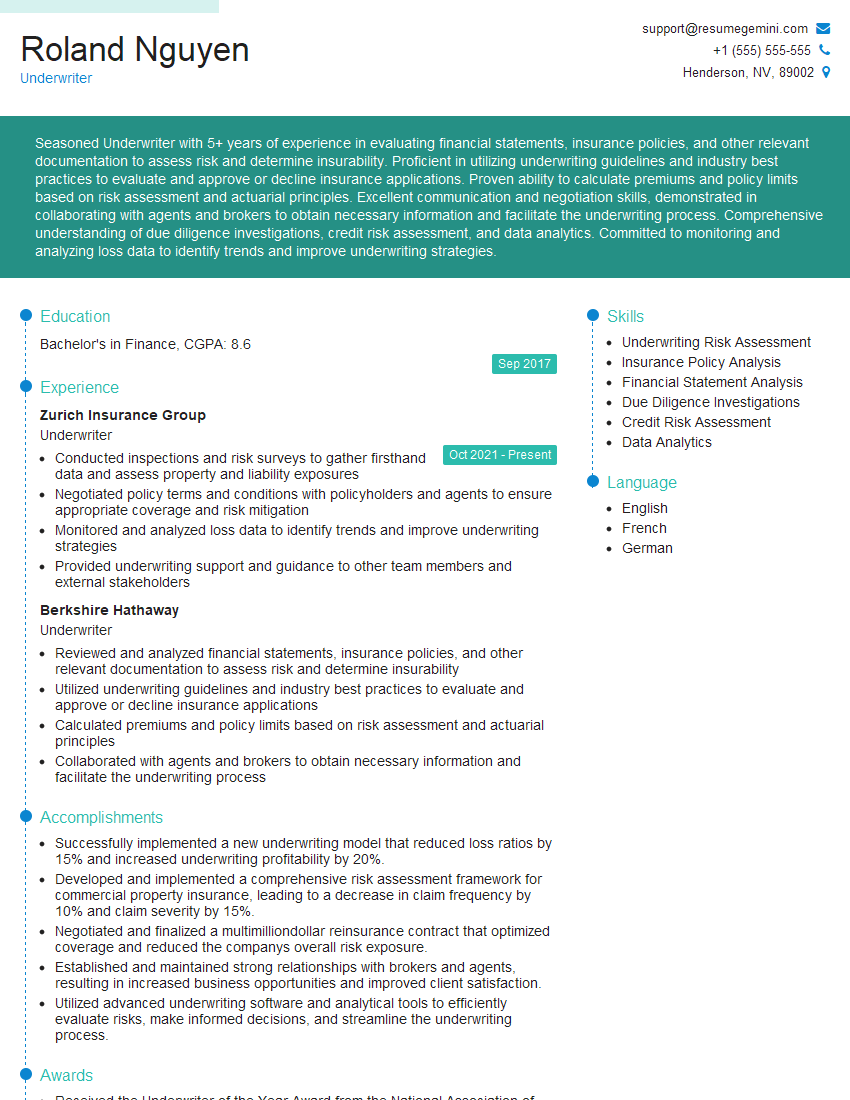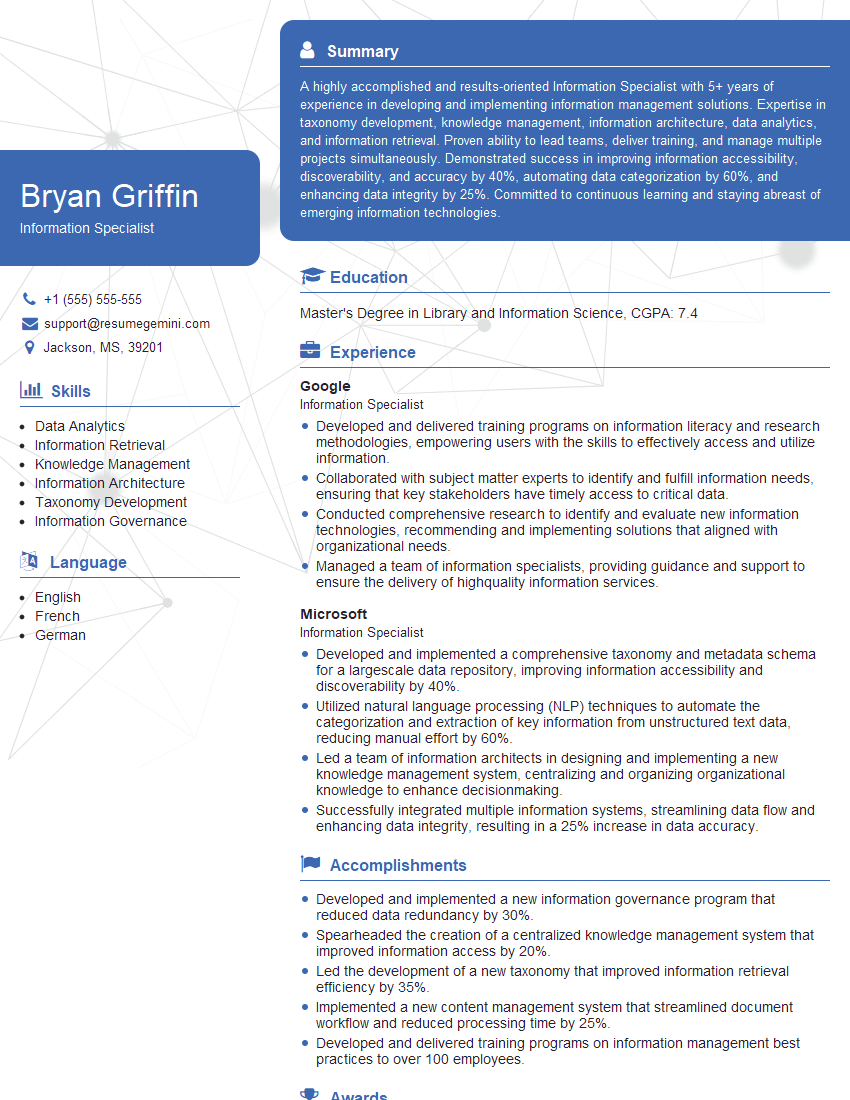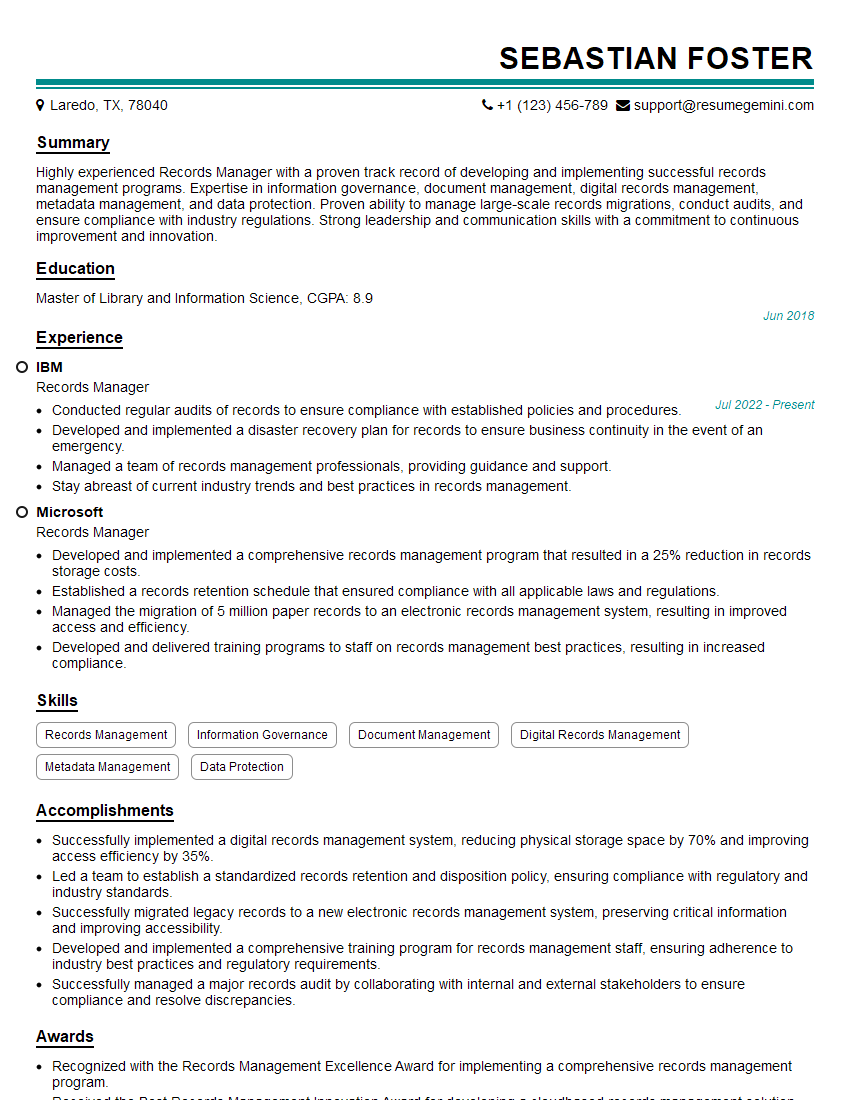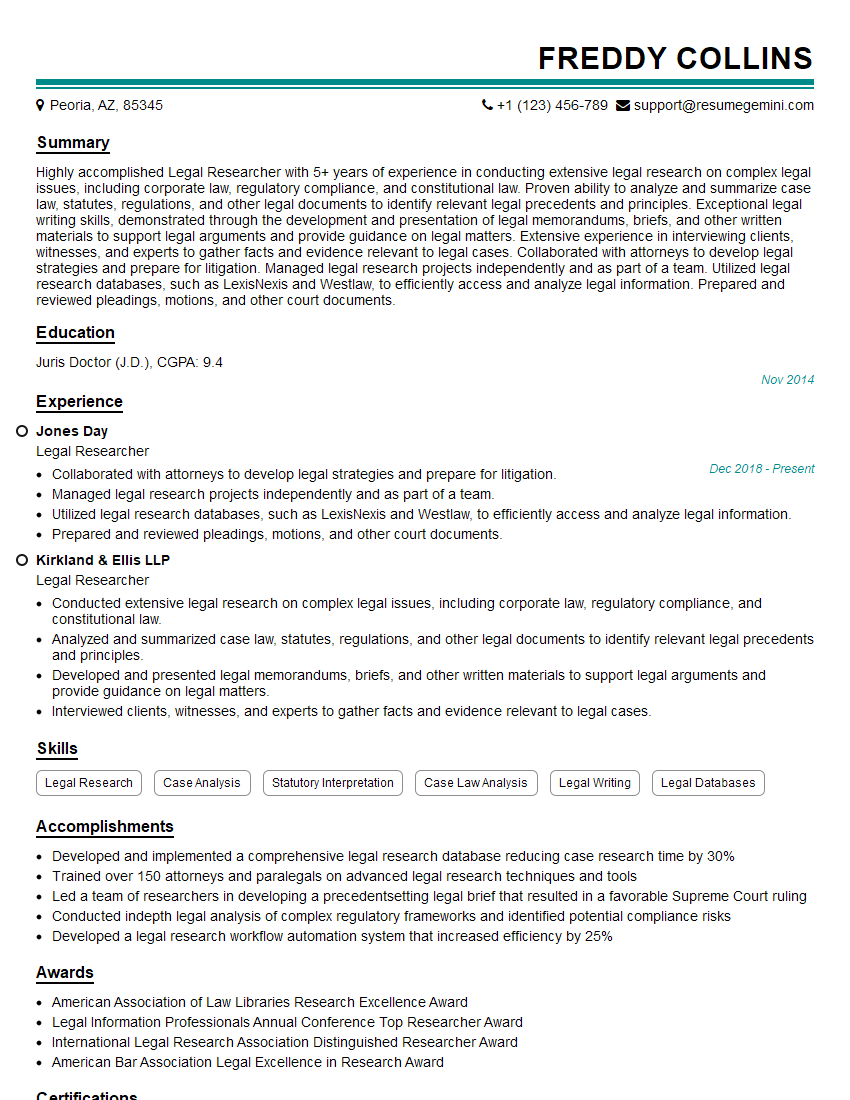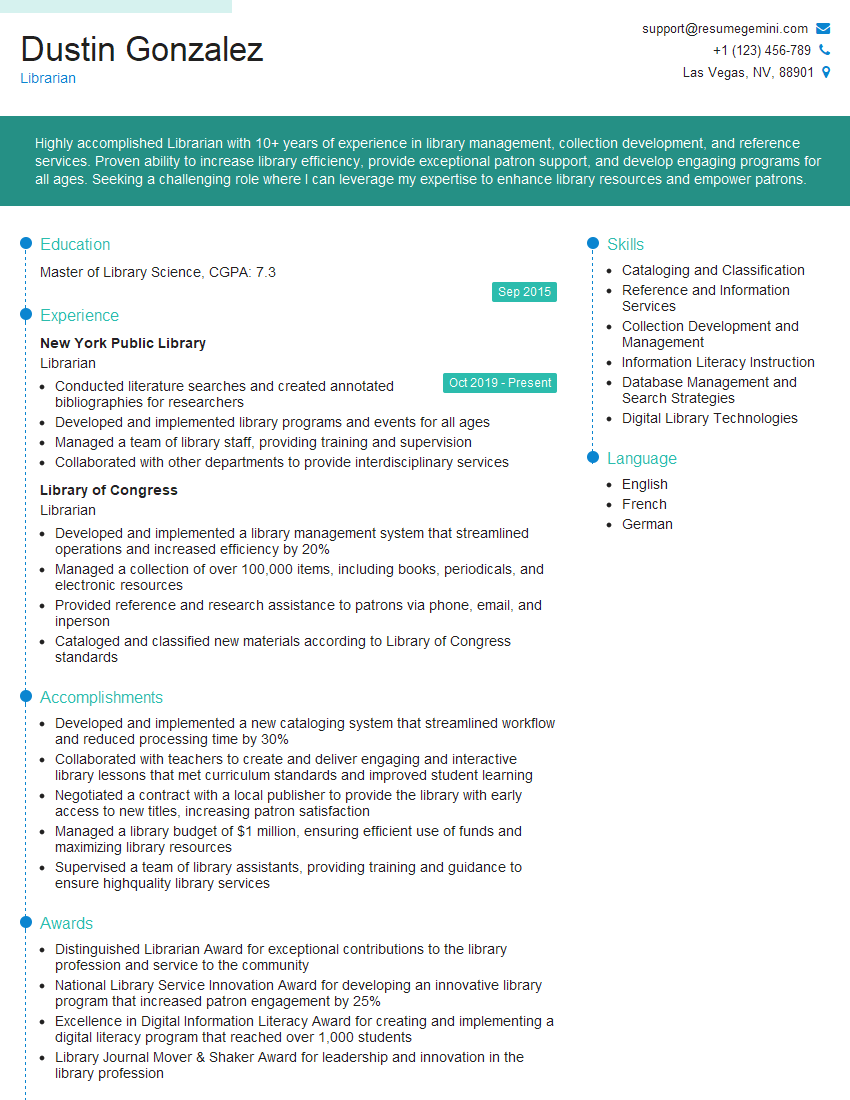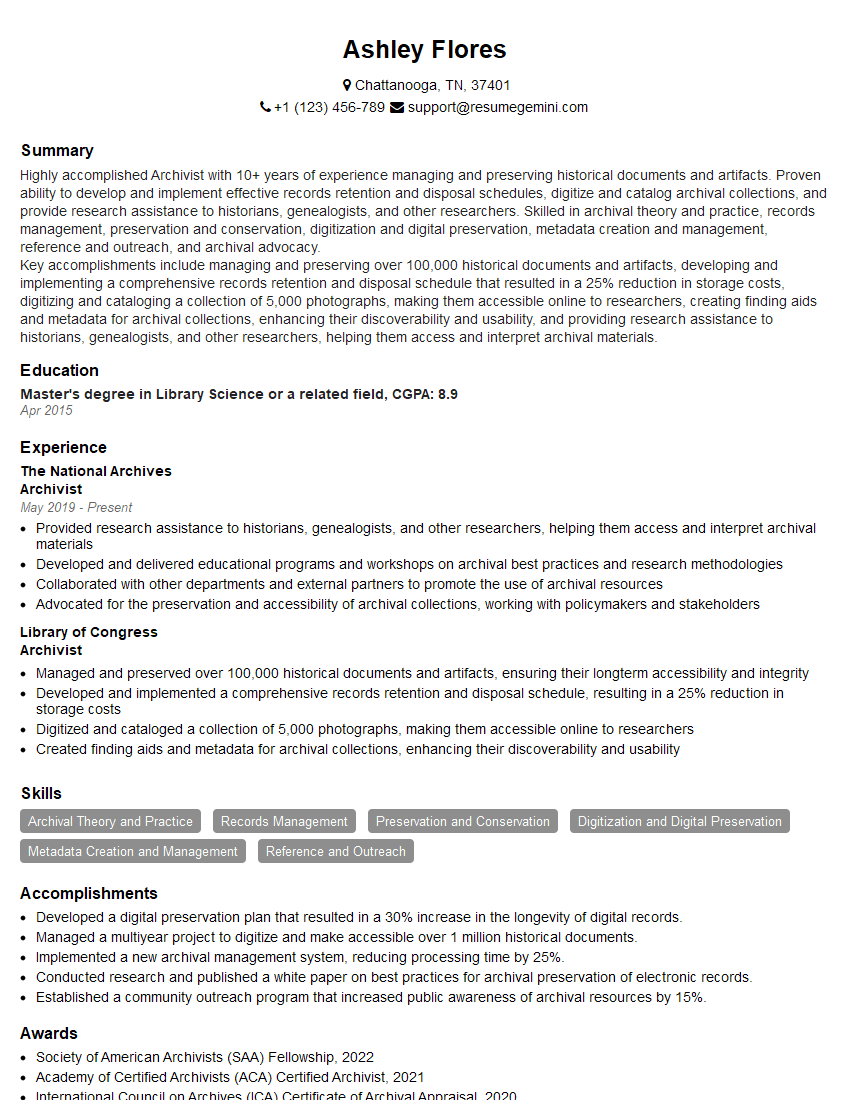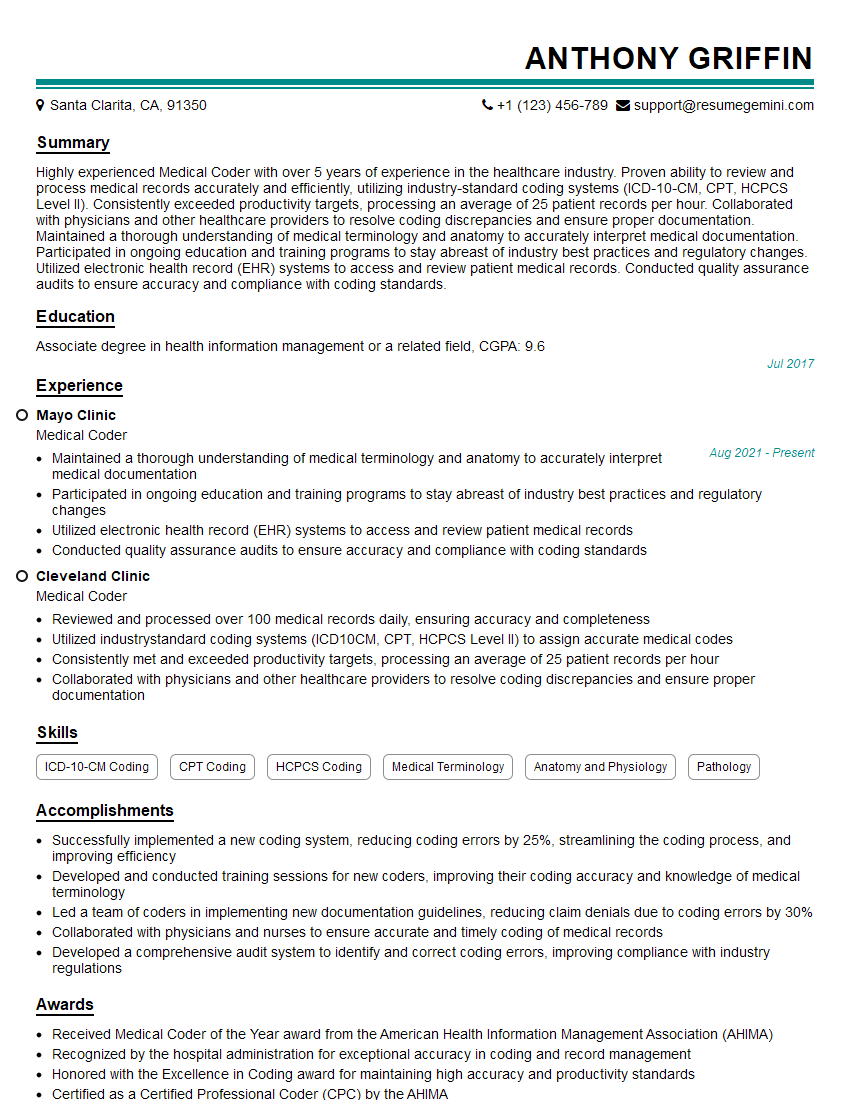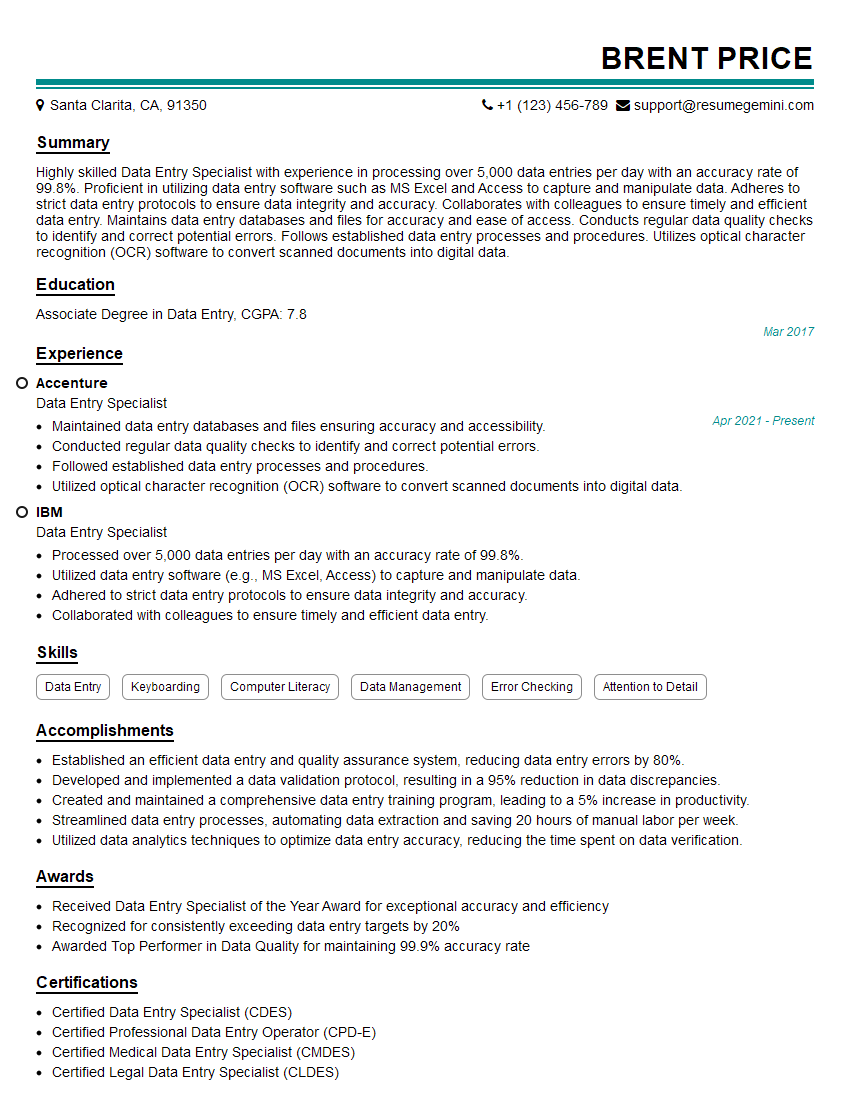Unlock your full potential by mastering the most common Cross-Referencing interview questions. This blog offers a deep dive into the critical topics, ensuring you’re not only prepared to answer but to excel. With these insights, you’ll approach your interview with clarity and confidence.
Questions Asked in Cross-Referencing Interview
Q 1. Explain the process of cross-referencing data from multiple sources.
Cross-referencing data from multiple sources involves systematically comparing and integrating information from different datasets to identify overlaps, discrepancies, and inconsistencies. Think of it like piecing together a puzzle where each dataset is a piece. The goal is to create a complete and accurate picture.
The process typically involves these steps:
- Data Preparation: Cleaning, transforming, and standardizing data from each source to ensure compatibility. This includes handling missing values, dealing with different data formats (e.g., dates, numbers), and ensuring consistent naming conventions.
- Data Matching: Identifying common keys or identifiers that link records across different datasets. This might involve using exact matches, fuzzy matching (for approximate matches), or record linkage techniques.
- Data Comparison: Comparing corresponding fields across matched records to identify discrepancies. This often involves automated checks, but manual review is frequently necessary.
- Data Integration: Combining data from different sources, resolving inconsistencies, and creating a unified dataset. This might involve choosing a ‘master’ dataset, or creating a new integrated dataset.
- Data Validation: Checking the accuracy and completeness of the integrated dataset. This involves data quality checks and potentially further analysis.
For example, imagine cross-referencing customer data from a sales database, a marketing database, and a customer service database. Data preparation might involve standardizing addresses and phone numbers. Data matching would link records based on customer ID. Comparison would reveal discrepancies in purchase history or contact preferences. Integration would create a complete customer profile.
Q 2. What techniques do you use to ensure accuracy when cross-referencing?
Ensuring accuracy in cross-referencing requires a multi-faceted approach. It’s not just about technology, but also careful methodology and human oversight.
- Data Quality Checks: Before even beginning the process, thoroughly assess the quality of each individual dataset. This includes checking for completeness, accuracy, and consistency within each source. This helps catch problems early.
- Multiple Matching Techniques: Employing various matching techniques (exact, fuzzy, probabilistic) to identify as many matches as possible, minimizing missed links. This increases the robustness of the process.
- Automated Checks and Validation Rules: Using scripts or software to automatically identify inconsistencies, such as mismatched dates or improbable values. This helps catch obvious errors quickly.
- Manual Review and Validation: Crucially, involve manual review, especially for complex or ambiguous cases. A human expert can identify patterns or nuances that automated tools may miss. This often involves sampling a subset of the data for validation.
- Documentation: Meticulously document the process, including data sources, matching rules, and any decisions made during the resolution of discrepancies. This improves traceability and reproducibility.
Think of it like a detective investigating a case – you need to gather evidence (data), verify its validity (data quality checks), and follow procedures (matching techniques) to solve the puzzle (integrate data) and present your findings (documentation).
Q 3. Describe a time you identified inconsistencies while cross-referencing data. How did you resolve it?
During a project cross-referencing customer purchase data with their loyalty program data, I discovered inconsistencies in customer IDs. Some customers had multiple IDs in the purchase database, while others were missing from the loyalty program database altogether. This created inaccuracies in calculating customer lifetime value and targeting marketing campaigns.
To resolve this, I first investigated the root cause. I found that the purchase database hadn’t been updated with the most recent customer ID changes from the loyalty program. I then took several steps:
- Data Cleaning: I identified and corrected duplicate customer IDs in the purchase database, prioritizing the most recent ID.
- Reconciliation: I worked with the database administrators to reconcile missing customer records, using available contact information to merge relevant data.
- Process Improvement: I recommended improved data synchronization processes to prevent similar inconsistencies in the future. This included automated updates between the two systems.
The result was a more accurate and reliable dataset for analytics and marketing efforts. The resolution highlighted the importance of understanding data lineage and establishing consistent data management practices.
Q 4. How do you handle large datasets when cross-referencing?
Handling large datasets in cross-referencing requires efficient strategies to avoid overwhelming computing resources and ensure timely completion. Key techniques include:
- Data Partitioning: Breaking down the large datasets into smaller, manageable chunks. This allows parallel processing and reduces memory requirements.
- Sampling: Analyzing a representative subset of the data to identify potential issues before processing the entire dataset. This saves time and resources.
- Database Optimization: Utilizing database indexes and optimized queries to speed up data retrieval and matching. The choice of database technology (e.g., relational, NoSQL) also plays a crucial role.
- Distributed Computing: Using cluster computing or cloud-based platforms to distribute the processing across multiple machines, significantly reducing processing time.
- Incremental Processing: Processing only new or changed data, rather than the entire dataset each time. This is beneficial when dealing with continuously updated data sources.
For instance, instead of comparing a million customer records at once, we might partition them into smaller batches of 100,000 for parallel processing. Sampling can be used to test different matching strategies on a subset of data before applying them to the entire dataset, which helps prevent errors during large-scale operations.
Q 5. What software or tools are you proficient in using for cross-referencing?
My proficiency extends to a range of software and tools used in cross-referencing. These include:
- SQL and database management systems (DBMS): I’m highly proficient in SQL for querying, manipulating, and joining data from relational databases like MySQL, PostgreSQL, and Oracle.
- Data integration tools: I have experience with tools such as Informatica PowerCenter, Talend Open Studio, and Apache Kafka for extracting, transforming, and loading (ETL) data from various sources.
- Programming languages: I’m proficient in Python, using libraries like Pandas and scikit-learn for data cleaning, transformation, and advanced matching techniques (e.g., fuzzy matching).
- Data visualization tools: Tools like Tableau and Power BI are essential for visualizing the results of cross-referencing, helping identify patterns and outliers.
The specific tool selection depends on the nature of the data, the scale of the project, and the required level of automation.
Q 6. How do you prioritize data sources when discrepancies arise during cross-referencing?
Prioritizing data sources when discrepancies arise requires careful consideration of data quality, reliability, and the context of the information. There’s no single answer, but here’s a structured approach:
- Data Source Evaluation: Assess the accuracy, completeness, and timeliness of each source. Consider factors such as data governance policies, data validation processes, and the reputation of the source.
- Data Validation and Verification: Investigate the reasons for the discrepancies. Are they due to data entry errors, data transformation issues, or differences in data definitions? The most reliable source will often have better validation mechanisms.
- Business Context and Impact: Evaluate the impact of choosing one data source over another on downstream processes or decisions. This might involve considering factors such as regulatory requirements or business rules.
- Documentation and Traceability: Record the rationale behind the choice of data source in the project documentation. This helps in case of future audits or questions about data integrity.
For example, if a discrepancy exists between a primary database and a secondary data entry system, I might prioritize the primary database, assuming it has a more rigorous data validation process in place and better data quality overall. But if the secondary system provides critical updates not yet reflected in the primary system, further investigation and reconciliation would be necessary.
Q 7. What are the potential consequences of inaccurate cross-referencing?
Inaccurate cross-referencing can have severe consequences, impacting various aspects of an organization.
- Inaccurate Reporting and Analysis: This leads to flawed business intelligence, potentially influencing critical strategic decisions based on faulty information.
- Financial Losses: Errors in financial data cross-referencing can result in incorrect accounting, missed payments, or overpayments.
- Damaged Reputation: Inaccurate customer data or other publicly available information can harm an organization’s reputation and customer trust.
- Regulatory Non-Compliance: Incorrect data in regulatory reporting can lead to significant fines and penalties.
- Operational Inefficiencies: Inaccurate data can disrupt workflows and create confusion throughout the organization.
For instance, incorrect customer data leading to improper targeted advertising could damage brand reputation and result in wasted marketing spend. Similarly, faulty financial reporting can lead to legal issues, financial losses, and damage to stakeholder trust.
Q 8. How do you maintain data integrity while cross-referencing?
Maintaining data integrity during cross-referencing is paramount. It’s like building a sturdy bridge – if one component is weak, the entire structure is compromised. We achieve this through several key strategies:
- Data Validation: Before cross-referencing, I rigorously validate each data source. This involves checking data types, formats, and ranges to ensure consistency. For example, if one dataset uses ‘MM/DD/YYYY’ for dates and another uses ‘YYYY-MM-DD’, inconsistencies need to be resolved before cross-referencing.
- Source Tracking: Maintaining a detailed audit trail of data sources is crucial. This allows me to trace any inconsistencies back to their origin and rectify the issue at the source. Think of it like detective work, identifying the culprit responsible for flawed information.
- Hashing and Checksums: Using hashing algorithms to generate unique identifiers for data records ensures that no data is accidentally duplicated or altered. This is akin to giving each data point a unique fingerprint.
- Error Handling and Reporting: Robust error handling mechanisms identify and document any discrepancies or conflicts during the cross-referencing process. This generates a report that guides further investigation and correction.
By implementing these strategies, I ensure the resulting cross-referenced data is accurate, reliable, and free from inconsistencies.
Q 9. Describe your experience with different cross-referencing methodologies.
My experience encompasses various cross-referencing methodologies, each suited to different data structures and objectives. I’ve worked with:
- Relational Database Joins: This is a foundational method for cross-referencing structured data using SQL. For instance, using
INNER JOIN,LEFT JOIN, orFULL OUTER JOINto combine data from multiple tables based on shared keys. - Record Linkage Techniques: For less structured data or data with imperfect matches, I utilize probabilistic record linkage techniques. This involves using string matching algorithms, phonetic matching (like Soundex), and statistical methods to identify potential links between records from different sources. This is particularly useful when dealing with variations in names or addresses.
- Fuzzy Matching: For scenarios where data may contain typos or inconsistencies, fuzzy matching algorithms are invaluable. These algorithms compare data strings and identify matches based on similarity scores, effectively tolerating minor variations.
- Deduplication Algorithms: When dealing with large datasets, deduplication algorithms become essential to identify and eliminate duplicate entries. Techniques range from simple exact matching to more complex algorithms utilizing machine learning.
Choosing the right methodology depends on the data characteristics, accuracy requirements, and computational resources available.
Q 10. How do you identify and handle duplicate data entries during cross-referencing?
Identifying and handling duplicate data entries is crucial for maintaining data integrity. I employ a multi-pronged approach:
- Exact Matching: First, I employ exact matching to find identical entries based on key fields. This is a quick and straightforward method but might miss near-duplicates.
- Fuzzy Matching and Similarity Scores: For near-duplicates, I use fuzzy matching algorithms that compare records based on similarity scores. This accounts for typos, variations in spellings, and other minor inconsistencies.
- Deduplication Software: I leverage specialized deduplication software to handle large datasets efficiently. These tools often incorporate sophisticated algorithms and offer features like manual review and automated merging options.
- Rule-based Deduplication: In some cases, I define rules based on domain knowledge to identify duplicates. For example, if two records have identical social security numbers, they’re likely duplicates.
After identifying duplicates, I decide whether to merge them, delete one, or flag them for manual review depending on the context and data quality requirements.
Q 11. How do you manage the time constraints associated with cross-referencing large datasets?
Cross-referencing large datasets can be time-consuming. To manage time constraints, I adopt these strategies:
- Data Sampling: I may begin by analyzing a representative sample of the data to optimize algorithms and identify potential issues early on. This reduces processing time for the entire dataset.
- Parallel Processing: I utilize parallel processing techniques to divide the workload across multiple processors or machines, significantly reducing overall processing time. Think of it as distributing the workload among a team, speeding up the completion.
- Optimized Algorithms: Choosing efficient algorithms and data structures is critical. For instance, using hash tables for efficient lookups is far superior to linear searches.
- Data Partitioning: Large datasets are often partitioned into smaller, more manageable chunks to process independently and then combine the results.
- Incremental Updates: Rather than reprocessing the entire dataset each time, I implement incremental updates to process only the newly added or changed data, significantly reducing the processing time.
By using a combination of these techniques, I can complete cross-referencing tasks efficiently, even with very large datasets.
Q 12. Can you explain the concept of data reconciliation in the context of cross-referencing?
Data reconciliation, in the context of cross-referencing, is the process of identifying and resolving discrepancies between datasets. It’s like comparing two versions of a document and highlighting the differences. After cross-referencing, I perform reconciliation to:
- Identify Conflicts: Pinpoint instances where information from different sources conflicts, such as differing addresses or dates.
- Investigate Discrepancies: Determine the root cause of these conflicts. This might involve examining data quality, identifying errors, or investigating possible inconsistencies.
- Resolve Conflicts: Decide which data source to prioritize or create a new consolidated entry that accurately reflects the available information. This often involves a combination of automated and manual processes.
- Document Resolutions: Maintain a detailed record of the reconciliation process, including the resolution applied for each identified discrepancy. This aids in auditing and provides insights into data quality.
A robust reconciliation process is essential for ensuring the accuracy and reliability of the final cross-referenced dataset.
Q 13. What strategies do you employ to detect and prevent errors during cross-referencing?
Error detection and prevention are critical throughout the cross-referencing process. My strategies include:
- Data Validation Rules: I define strict validation rules at each stage to catch errors early on. This includes checks for data type, format, range, and consistency across fields.
- Data Profiling: I analyze the data to understand its structure, identify potential anomalies, and determine the level of data quality before cross-referencing begins.
- Unit Testing: I perform unit testing on individual components of the cross-referencing process to ensure that each part functions correctly.
- Sanity Checks: After cross-referencing, I perform sanity checks by visually inspecting subsets of the data or using summary statistics to identify any obvious inconsistencies.
- Automated Error Reporting: I implement automated systems to flag potential errors and generate detailed reports for review and correction.
A proactive approach to error detection and prevention is essential for producing high-quality cross-referenced data.
Q 14. How do you determine the reliability of different data sources?
Determining the reliability of data sources is a crucial step. I consider several factors:
- Source Reputation: I assess the reputation and trustworthiness of the data source. For example, data from government agencies are typically more reliable than data from unverified websites.
- Data Quality: I evaluate the data quality using metrics such as completeness, accuracy, consistency, and timeliness. This includes examining the presence of missing values, outliers, and inconsistencies within the data itself.
- Metadata: The availability and quality of metadata (data about data) provides valuable insights into the data collection methods, processing steps, and potential limitations. This provides context for understanding the data’s limitations.
- Data Validation: I perform rigorous data validation to identify errors and inconsistencies. This includes checking data types, formats, and ranges to ensure consistency.
- Cross-Validation: Where possible, I compare data from multiple sources to cross-validate findings and identify discrepancies. This helps in identifying inaccuracies in individual data sources.
A comprehensive evaluation of these factors helps determine the reliability of different data sources and inform decisions on how to best use the data in the cross-referencing process. Weighting the sources based on their reliability is essential for accurate conclusions.
Q 15. How do you document your cross-referencing process for auditability?
Maintaining a meticulous audit trail is paramount in cross-referencing. Think of it like a detective meticulously documenting every step of an investigation. My process involves creating a comprehensive log that includes:
- Date and Time Stamp: For every action taken, from data import to final reconciliation.
- Source Data Files: Precisely identifying the origin of each dataset. This includes version numbers if applicable.
- Transformation Steps: Detailed description of any cleaning, transformation, or manipulation of the data. Example:
'Removed duplicate entries based on unique ID field' - Cross-reference Logic: A clear explanation of the matching criteria used. For example, ‘Matched records based on both ‘CustomerID’ and ‘Order Date’ fields.’
- Discrepancies and Resolutions: A record of any inconsistencies found and the steps taken to resolve them. This should include the specific data points and the rationale behind the resolution.
- User Actions: Tracking any changes made by individuals involved in the process, especially crucial for collaborative projects.
This detailed documentation allows for easy verification, facilitates error detection, and ensures compliance with auditing standards. It’s all about creating a complete and transparent history of the process.
Career Expert Tips:
- Ace those interviews! Prepare effectively by reviewing the Top 50 Most Common Interview Questions on ResumeGemini.
- Navigate your job search with confidence! Explore a wide range of Career Tips on ResumeGemini. Learn about common challenges and recommendations to overcome them.
- Craft the perfect resume! Master the Art of Resume Writing with ResumeGemini’s guide. Showcase your unique qualifications and achievements effectively.
- Don’t miss out on holiday savings! Build your dream resume with ResumeGemini’s ATS optimized templates.
Q 16. Explain how you ensure consistency in data formatting during cross-referencing.
Consistency in data formatting is essential for accurate cross-referencing. Think of it like aligning the pieces of a jigsaw puzzle – if the shapes don’t match, you won’t get a clear picture. I employ several strategies to ensure consistency:
- Standardized Data Cleaning: Before any cross-referencing begins, I use scripting (e.g., Python with Pandas) to standardize data formats. This includes handling inconsistent date formats (e.g., converting MM/DD/YYYY to YYYY-MM-DD), dealing with extra whitespace, and correcting inconsistent capitalization.
- Data Type Validation: Ensuring all data fields are of the correct type (e.g., numeric, string, date) prevents errors during the matching process. I’ll often use validation checks within my scripts to flag and address data type mismatches.
- Schema Definition: For structured data formats like XML or JSON, I create clear schemas which define the expected data types and structures. This acts as a blueprint to ensure consistency.
- Automated Checks: I leverage automated scripts to perform checks for inconsistencies in formatting throughout the cross-referencing process, catching issues before they propagate.
By proactively addressing formatting inconsistencies, I minimize errors and guarantee the reliability of the cross-referencing results.
Q 17. How do you handle missing or incomplete data when cross-referencing?
Handling missing or incomplete data is a critical aspect of cross-referencing. Ignoring these issues can lead to inaccurate or incomplete results. My approach involves:
- Data Profiling: I begin by analyzing the data to identify the extent of missing or incomplete information. This helps to understand the nature and scope of the problem.
- Data Imputation (with caution): In some cases, where missing data can be reliably estimated, I may employ imputation techniques. This could involve filling in missing values with the mean, median, or mode for numerical data or using a ‘most frequent’ value for categorical data. However, I clearly document any imputation done and only do it when appropriate to avoid introducing bias.
- Flagging Missing Data: I often mark incomplete records, clearly distinguishing them from complete ones in the output. This allows for informed decision-making and prevents misinterpretations. This could be a simple ‘Missing Data’ flag or the use of ‘NULL’ values.
- Reconciliation Reports: I generate reports that summarize the number and types of incomplete records encountered, providing context for potential inaccuracies in the final cross-reference.
The key is transparency – acknowledging and documenting how missing data is handled is critical for maintaining data integrity and avoiding misleading conclusions.
Q 18. Describe your experience using different data formats (e.g., CSV, XML, JSON) for cross-referencing.
I have extensive experience working with various data formats for cross-referencing, each presenting its own challenges and advantages.
- CSV (Comma Separated Values): Simple, widely used, and easy to process with scripting languages like Python. Ideal for simpler cross-referencing tasks. Example:
import pandas as pd; df = pd.read_csv('data.csv') - XML (Extensible Markup Language): More structured than CSV, allowing for complex data relationships. Requires using XML parsing libraries (e.g., ElementTree in Python). Good for handling hierarchical data structures.
- JSON (JavaScript Object Notation): Another structured format, but often preferred over XML due to its readability and easier parsing. Python’s
jsonlibrary is readily available for working with JSON data.
The choice of format depends on the complexity of the data and the specific cross-referencing task. Regardless of the format, I always prioritize data validation and schema definition for consistency and accuracy.
Q 19. What quality control measures do you implement to ensure the accuracy of cross-referenced data?
Quality control is paramount in cross-referencing. I implement several measures to ensure accuracy:
- Data Validation Checks: Before, during, and after cross-referencing, I perform comprehensive checks on data integrity. This includes verifying data types, checking for inconsistencies, and assessing the completeness of data.
- Random Sampling and Verification: I randomly select a subset of the cross-referenced data for manual verification, ensuring the automated process is accurate. This is especially important for critical data sets.
- Automated Consistency Checks: My scripts include automated checks to identify and flag potential errors or inconsistencies. This ensures that problems are detected early in the process.
- Duplicate Detection: I incorporate mechanisms for detecting duplicate records to prevent erroneous matching and ensure unique identification of each data point.
- Cross-Validation: When possible, I cross-validate the results against independent data sources to verify the accuracy of the cross-referencing.
These quality control measures provide a multifaceted approach to guaranteeing data accuracy and reliability.
Q 20. How do you communicate the results of your cross-referencing efforts to stakeholders?
Communicating cross-referencing results effectively is crucial for stakeholder buy-in and informed decision-making. My approach involves:
- Clear and Concise Reporting: I generate reports that are easy to understand, presenting the findings in a clear and concise manner. This often includes visualizations like charts and graphs to highlight key insights.
- Summary of Key Findings: I start with a brief executive summary, highlighting the main results and their implications.
- Detailed Data Tables: I include detailed tables containing the cross-referenced data, clearly showing the matching criteria and any discrepancies found.
- Visualizations: Visualizations, like Venn diagrams or network graphs, are particularly helpful in presenting complex relationships in a more accessible way.
- Interactive Dashboards (when appropriate): For large and complex datasets, I may create interactive dashboards that allow stakeholders to explore the data and customize their views.
- Presentation and Discussion: I present the findings to stakeholders, ensuring an opportunity for questions and discussions. This ensures everyone is on the same page and understands the implications of the cross-referencing results.
The goal is to provide stakeholders with not only the data but also the context and insights they need to make informed decisions.
Q 21. Describe your experience with cross-referencing data in a regulated environment.
I have considerable experience with cross-referencing data in regulated environments, particularly adhering to standards like HIPAA (for healthcare data) or GDPR (for personal data). In these contexts, data security, accuracy, and auditability are paramount. My approach incorporates:
- Data Security and Privacy: I strictly adhere to all relevant data protection regulations. This includes securing data during transit and at rest, using encryption where necessary, and implementing access control measures to restrict access to authorized personnel only.
- Data Masking and Anonymization: When dealing with sensitive data, I use data masking techniques to protect personally identifiable information (PII) while preserving the integrity of the data for cross-referencing purposes.
- Detailed Audit Trails: As mentioned previously, maintaining a meticulous audit trail is critical in regulated environments to meet compliance requirements. This allows for thorough review and verification of the entire process.
- Validation against Compliance Standards: I meticulously verify that the cross-referencing process adheres to all applicable regulations and internal policies. This often involves reviewing regulatory documents and internal compliance guidelines.
- Documentation for Audits: All steps of the process, including the rationale behind choices made, are thoroughly documented to support audits and demonstrate compliance.
Working with regulated data requires a rigorous and meticulous approach, prioritizing security and compliance at every step of the process.
Q 22. What are some common challenges you face when cross-referencing data, and how do you overcome them?
Cross-referencing, while powerful, presents several challenges. Inconsistent data formats are a major hurdle. Imagine trying to match customer records from a system using full names with another using only initials! Another common issue is missing or incomplete data – a crucial identifier might be absent in one source, preventing a match. Data quality itself can be problematic; typos, outdated information, or ambiguous entries make accurate cross-referencing extremely difficult. Finally, the sheer volume of data in large organizations can overwhelm manual processes and lead to errors.
To overcome these, I employ a multi-pronged approach. I start by thoroughly understanding the data sources, their structures, and potential inconsistencies. This involves data profiling – analyzing data types, identifying missing values, and detecting anomalies. I then create standardized data schemas whenever possible, ensuring consistent formatting across sources. Data cleaning is essential; this involves handling missing values using appropriate imputation techniques (e.g., mean, median, or mode substitution) and correcting or standardizing inconsistent entries. For large datasets, I leverage automated tools and techniques like fuzzy matching (for approximate string matching) and deduplication algorithms to efficiently identify and link related records. Regular validation and quality checks are crucial throughout the process, ensuring the accuracy of the cross-referenced data.
Q 23. How do you adapt your cross-referencing techniques to different data types and structures?
Adapting cross-referencing techniques to different data types and structures requires flexibility and a deep understanding of data manipulation techniques. For example, cross-referencing textual data (like customer comments) requires different approaches than numerical data (like sales figures). Textual data may involve natural language processing (NLP) techniques like stemming and lemmatization to normalize words, along with techniques like cosine similarity to compare document content. Numerical data may need statistical analysis and outlier detection to identify potential inaccuracies before cross-referencing. Structured data (like relational databases) lends itself well to SQL queries and joins; while unstructured data (like free-form text) often demands machine learning models for pattern recognition and information extraction.
Consider a scenario where I’m cross-referencing customer purchase history with their demographic data. Purchase history might reside in a transactional database, while demographics are in a separate CRM system. I would use SQL joins to link records based on a common customer ID. However, if customer names are used instead, and there are inconsistencies, fuzzy matching becomes crucial. In essence, my approach is to choose the most appropriate tools and techniques for the specific data types and structures involved, prioritizing accuracy and efficiency.
Q 24. How do you prioritize tasks when dealing with multiple cross-referencing projects simultaneously?
Prioritizing multiple cross-referencing projects involves a strategic approach focusing on urgency, impact, and dependencies. I employ a prioritization matrix, considering factors such as deadlines, business criticality, and potential downstream consequences of delays. Projects with imminent deadlines or those crucial for critical business decisions usually take precedence.
For example, if one project involves data required for a regulatory audit with a tight deadline, it would take priority over another project for internal reporting, which has a more flexible schedule. I also look for dependencies between projects; if one project’s output is an input for another, the dependent project is naturally prioritized later. Using project management tools with features like Gantt charts helps visualize task dependencies and deadlines, further enhancing efficient prioritization and resource allocation.
Q 25. Describe your experience with using automated tools for cross-referencing.
I have extensive experience utilizing automated tools for cross-referencing, dramatically improving efficiency and accuracy. Tools like OpenRefine (for data cleaning and transformation) and various ETL (Extract, Transform, Load) tools are invaluable for handling large datasets and automating repetitive tasks. Programming languages such as Python, with libraries like Pandas and scikit-learn, are essential for custom scripting and implementing advanced algorithms like fuzzy matching and machine learning models for more complex cross-referencing tasks.
For instance, I’ve used Python with Pandas to build a custom script to automatically cleanse and standardize customer addresses before linking them to geographic data for spatial analysis. This automated process drastically reduced manual effort and ensured consistency across a large dataset, minimizing errors caused by human intervention. The chosen tools always depend on the scale and complexity of the task and the characteristics of the data involved.
Q 26. How do you evaluate the effectiveness of your cross-referencing process?
Evaluating the effectiveness of cross-referencing hinges on several key metrics. Accuracy is paramount; this is assessed by comparing the cross-referenced data against trusted sources or by manual verification of a sample of linked records. Completeness is another vital metric – it measures the percentage of records successfully linked or matched. Efficiency is evaluated by tracking the time taken to complete the process and the resources utilized. Finally, the impact on downstream processes is crucial; does the cross-referenced data lead to improvements in decision-making, process efficiency, or reporting accuracy?
I often use a combination of quantitative and qualitative methods. Quantitative measures include accuracy rates, completeness rates, and processing times. Qualitative assessment may involve reviewing user feedback on the quality of the output and identifying any unexpected issues or errors.
Q 27. How do you stay updated on best practices for data verification and cross-referencing?
Staying updated on best practices requires continuous learning. I actively participate in relevant online communities and forums, attending webinars and conferences related to data management and quality. Following industry publications and influential researchers in the field of data science and information management is crucial. I regularly review updated documentation for the software tools I use. This ensures that I’m familiar with the latest features and best practices for data verification and cross-referencing techniques, thereby maintaining a high level of competency and proficiency in my work.
Q 28. Explain how you would approach cross-referencing data with conflicting information.
Handling conflicting information requires a structured approach, prioritizing accuracy and transparency. The first step is identifying and documenting all instances of conflict. Then, I investigate the source of the conflict – are the discrepancies due to data entry errors, outdated information, or genuine differences in perspectives or methodologies? Once the root cause is understood, I carefully evaluate the reliability and trustworthiness of each data source. This might involve assessing data quality metrics, examining data provenance, and consulting subject matter experts.
Based on this evaluation, I choose the most reliable source of information. If multiple sources are equally reliable, I may use data reconciliation techniques, such as averaging numerical data, or flag the conflicting data points for manual review and resolution. It’s crucial to document the conflict resolution process and its rationale for transparency and auditability. This ensures that the decision-making process is clear, allowing for future review and improvement.
Key Topics to Learn for Cross-Referencing Interview
- Understanding Data Integrity: Grasping the importance of accurate and consistent data across multiple sources is fundamental. Consider the implications of discrepancies and how they impact decision-making.
- Data Reconciliation Techniques: Explore various methods for identifying and resolving conflicting data points. This includes manual checks, automated tools, and algorithmic approaches. Practical application: Imagine reconciling customer data from a CRM with sales data from an ERP system.
- Data Validation and Cleaning: Learn to identify and correct inaccurate or incomplete data. Understanding data standardization and normalization techniques is crucial.
- Identifying and Resolving Data Conflicts: Develop strategies for analyzing conflicting data entries and determining the most accurate source. Consider prioritizing data based on reliability and source authority.
- Cross-Referencing Tools and Technologies: Familiarize yourself with software and tools used for data comparison and reconciliation. Understanding the strengths and limitations of different technologies is beneficial.
- Data Governance and Compliance: Understand the role of cross-referencing in maintaining data quality and adherence to regulatory standards.
- Problem-Solving and Analytical Skills: Demonstrate your ability to identify patterns, analyze data inconsistencies, and propose effective solutions. Prepare to discuss your approach to problem-solving in a cross-referencing context.
Next Steps
Mastering cross-referencing skills is invaluable for career advancement, opening doors to roles demanding high levels of accuracy and attention to detail. A strong understanding of data integrity and reconciliation techniques significantly enhances your employability across various industries. To maximize your job prospects, crafting an ATS-friendly resume is critical. ResumeGemini is a trusted resource to help you build a professional and effective resume that showcases your skills and experience. Examples of resumes tailored to Cross-Referencing roles are available for your review, providing valuable insights into how to present your qualifications effectively.
Explore more articles
Users Rating of Our Blogs
Share Your Experience
We value your feedback! Please rate our content and share your thoughts (optional).
What Readers Say About Our Blog
Hi, I’m Jay, we have a few potential clients that are interested in your services, thought you might be a good fit. I’d love to talk about the details, when do you have time to talk?
Best,
Jay
Founder | CEO

